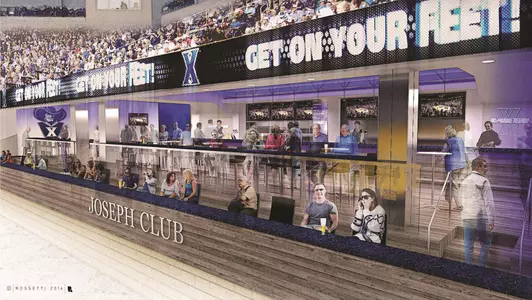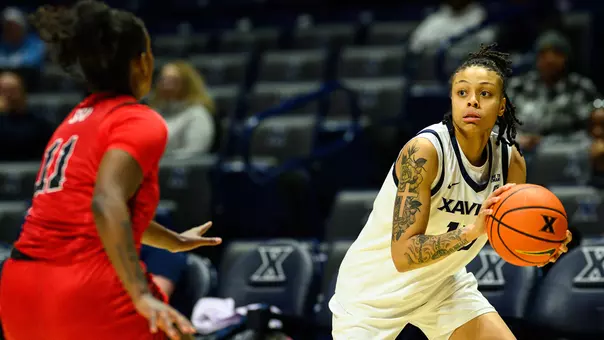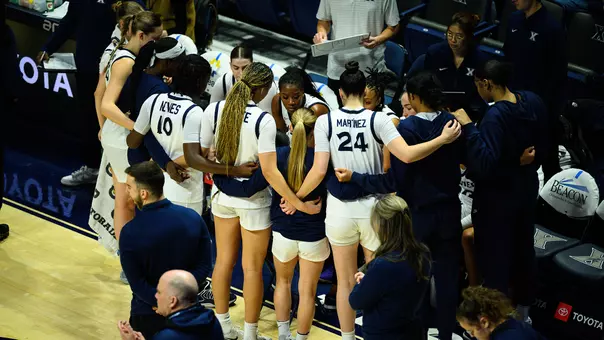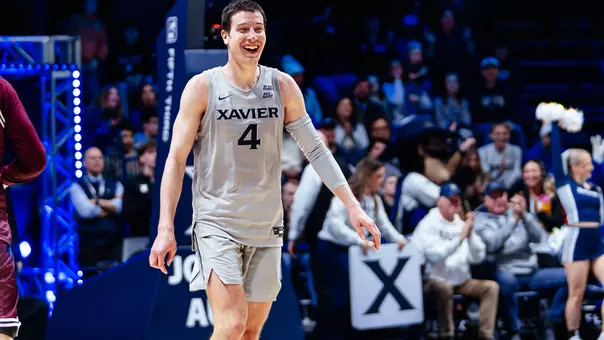Xavier University Athletics

Center Stage: Big Changes are Coming to Cintas Center
06.03.15 | Men's Basketball, Women's Basketball, Athletic Department
Written by Sue Vonderhaar for the 2nd edition of Xavier Nation Magazine
CENTER STAGE
Big Changes Are Coming To Cintas Center
By Sue Vonderhaar (written for Xavier Nation Magazine, 2nd Edition)
THE CHANGES COMING TO CINTAS CENTER WILL ENHANCE THE experience for fans and players--as if Xavier games could be any more exciting--and ensure that Cintas Center remains one of the premier basketball venues in the country for years to come.
It's all part of a seven-year, nearly $25 million renovation of the important Xavier landmark, a makeover that's well underway, as fans discovered this past season.
If you liked the new D'Artagnan's Deck and the skyline silhouette on the court, you'll love what's coming next.
Already this school year, $450,000 in improvements have been completed at the 10,250-seat arena, including new premium seating at courtside and on the bridge outside the banquet rooms, a "fueling station" in the weight room, and a modernized point-of-sale system at all concession stands.
That's just the beginning of a panoply of renovations and improvements to be staged over the next seven years.
For the fans, the makeover will create a more welcoming experience, or "sense of arrival," as they head to the game. New signage. New lighting. Redesigned concourses.
Other improvements will target the game experience itself. New club seats and party suites. A redesigned, more fan-friendly Joseph Club. New hospitality areas. Cup holders!
For student-athletes from all 18 of Xavier's sports teams--not just basketball and volleyball--the renovation will bring major expansions of practice courts, locker rooms, strength and conditioning facilities, plus a consolidation of academic tutoring space and study halls in one locale.
And the entire building--including the Schiff Conference Center and James & Caroline Duff Banquet Center--will benefit from significant technical upgrades and structural improvements.
Xavier Athletics Director Greg Christopher said that while the nearly $25 million expenditure will include a portion of the revenue from the BIG EAST/FOX-TV, the largest portion of the funding will come from private-gift fundraising.
Already more than $10 million in commitments have been secured from donors, he says, including a generous leadership gift from Robert J. Kohlhepp, chairman of Cintas Corporation and a former chair of Xavier University's Board of Trustees.
"Bob and his wife, Linda, have provided a gift that will provide resources for numerous projects in coming years," Christopher says, "and will also create a permanent endowment to ensure the upkeep of Xavier's most visible and most trafficked building."
Kohlhepp, who received his MBA from Xavier in 1971, is an avid supporter of Xavier athletics. He was a major force behind the creation of Cintas Center, and his name graces the Kohlhepp Family Auxiliary Gym in the center.
"Cintas Center is Xavier's front porch," Kohlhepp says, "and making sure it is in top condition for the next two decades is one of my top priorities. Xavier has been an important part of our lives, and Linda and I are happy to be a part of its long-term success."
Constructed at a cost of $46 million, the state-of-the-art Cintas Center opened in the fall of 2000, thanks to private donations raised as part of XU's Century Campaign. For years, it ranked among the best in the region. But after 15 years, it has started to show its age around the edges.
Christopher likens it to watching a new house begin to age.
"The first 10 years," he says, "you don't have to do anything to the house. It's all brand new. But after that, you need to start making fixes and repairs. And you want to modernize it, too."
Cintas Center is approaching middle age now, he says, which means some things have to be fixed or replaced. And it needs some updates to keep up with changing tastes and needs.
If you built a new arena today, Christopher explains, it would offer some new and different features. For instance, where suites were the only option 15 years ago, there is greater interest these days in club seating, like the Reds' Diamond Club section at Great American Ball Park. And craft-beer decks have started to replace traditional concession stands.
Perhaps more pressing, though, is the need for new technology. Cintas is not HD-compatible, Christopher says, and its developers back in 2000 could not have envisioned thousands of students using smartphones at the same time during a basketball game. So technical upgrades, including more robust WiFi and enhanced LED video boards, are a big priority.
This project won't be disruptive, though. Not like the University of Cincinnati's Nippert Stadium renovation, which forced UC to play last fall's home football games at Paul Brown Stadium during construction.
"We won't close it and start from scratch," Christopher says. Instead, each November for the next few seasons, fans will return to Cintas Center and find new features and improvements.
But fans shouldn't come back expecting anything like a mammoth Staples Center.
"Our intent is not to add capacity," Christopher says. "Cintas Center is already a terrific venue for basketball and other events, and it's an important home-court advantage."
Indeed, Cintas Center ranks as one of the country's toughest venues for visiting teams, and the university wants to ensure that reputation endures. During the first 15 seasons at Cintas, the men's basketball team has compiled a 201--30 home record, thanks in large part to a packed arena every game and the Musketeers' frenzied following.
"Cintas Center provides us with a tremendous home-court advantage," says Chris Mack, Xavier men's basketball head coach, "and it's one of the nation's best on-campus arenas. The improvements at Cintas Center will continue to enhance an already exciting atmosphere and fan experience."
Attendance at Cintas Center now exceeds 2.3 million fans for men's basketball, and the Musketeers have averaged 10,013 fans for the 231 games played inside the arena since it opened (including 126 sell-outs). That's 97.7 percent capacity.
"I'd much rather have a smaller arena with a great atmosphere," Christopher says, "than a huge impersonal facility. We don't want to weaken that home-court advantage."
When Christopher joined XU two years ago, his first priority was to develop a strategic plan for Xavier athletics. The Musketeers were about to join the BIG EAST, and the men's basketball team was enjoying increasing success in the NCAA Tournament. This season was no exception. Since 2000, every freshman class has been a part of a run to the Sweet 16.
Christopher and his staff recognized that Cintas Center building, while in need of updating, was a key strategic resource for the university--and not just for the home-court advantage. Unlike other schools, such as Georgetown, which pays rent to use Washington, D.C.'s Verizon Center, the Musketeers play on their own campus in their own house. So not only does Xavier have that special on-campus advantage, it also gets to keep the revenue from sports, concerts, banquets, and other Cintas Center events. It costs roughly $500,000 a year to maintain and operate Cintas Center, Christopher says, and thanks to basketball revenue and the standalone conference center, it essentially breaks even.
Christopher's staff also saw a need to improve the facilities for Xavier's student-athletes. Cintas Center originally was designed only for basketball and volleyball, he says, but now, 18 different XU teams use its facilities for various purposes, including practice courts, strength and conditioning, and training. A big goal of the renovation, he says, was to expand those facilities. Another goal, he says, was to consolidate the academic-support program. Right now, study halls and tutoring are spread out across campus. But when Cintas Center expansion is complete, all of those programs will be concentrated in one place within the center.
To devise a master plan for the renovation and expansion, Xavier turned to Detroit-based Rossetti, a leading architectural and design firm in the sports industry. Rossetti was asked to evaluate the aging center's needs and explore renovating Cintas with two primary objectives: 1) maximize fan experience and explore untapped revenue ideas; 2) make the most effective use of space dedicated to student-athlete practice, training, and academic support.
The resulting master plan was broken into four major "bucket lists" of projects roughly corresponding to: Fan Experience, Team and Student-Athlete Impact, Facility Priorities, Look and Feel.
Over the next seven years, individual projects within each of those broad categories will be prioritized to coincide with available funding and cash flow. And while Rossetti handles the big picture, a Cincinnati firm, Michael Schuster and Associates, will help turn the vision into reality.
Already in the works for next season are plans to convert the old Hoff student-dining hall into the new student-athlete academic area, where players will find new tutoring rooms, a computer lab, and study halls. Also, the first floor of Cintas Center soon will include a build-out on the north end to allow for brand-new strength and conditioning facilities and an expanded sports medicine area. Both spaces will almost double in size.
"I'm especially excited," Mack says, "about the planned improvements to our strength and conditioning area, training room, locker room, and academic facilities and resources. All of these improvements positively impact our recruiting and our ability to develop student-athletes to compete at the highest level."
Once those projects are completed, the Joseph Club will be redesigned. That project entails removing the glass wall, lowering the counter to loge height, and adding loge seats.
Also high on the list for next season: making Cintas Center HD-compatible and resolving the center's WiFi shortcomings. In addition, more club-seating options will be addressed.
After that, fans and players can expect a steady stream of surprises each fall for years to come.




